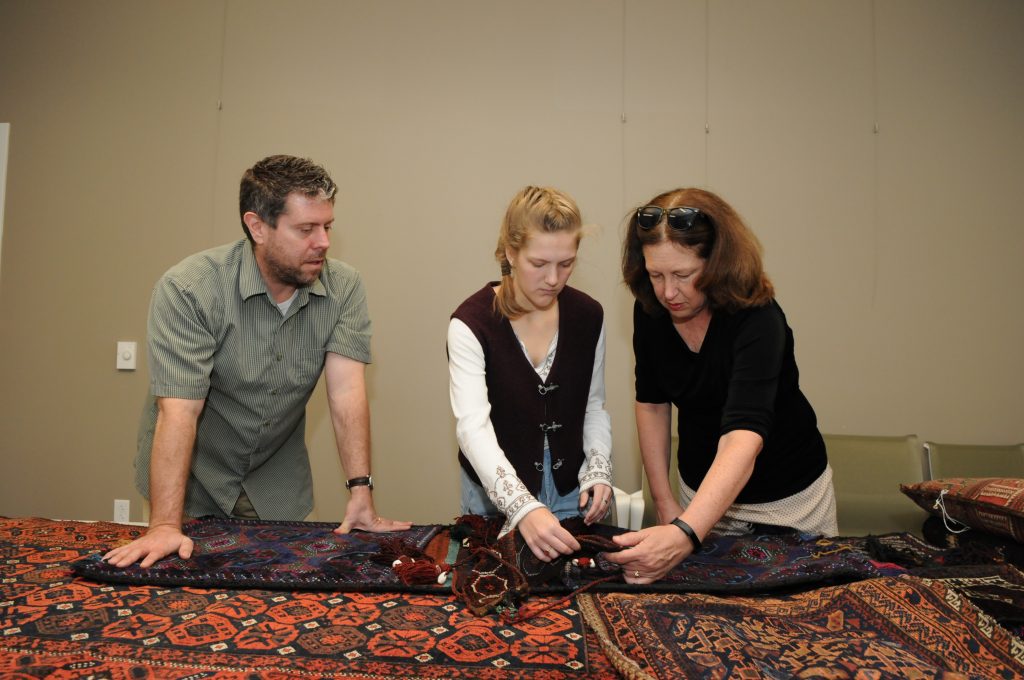In Hope College’s Kruizenga Art Museum, a current exhibit asks an unapologetic and perhaps overwhelming question: What exactly is art?
Is art aesthetically-pleasing work meant to only be seen and not touched? Must it hang on a wall or stand on a pedestal? Or, can art be practical, painstakingly-created pieces made for everyday use?
And who decides?
“Once Were Nomads,” on display through May 11, begs reflection on those questions. And here’s a spoiler alert: A life-size, fiberglass camel stands at the center of the exhibit offering insights toward some answers.
The harsh, Middle East region of the Baluch people is where those artisans create beautiful works of art that are constantly on the go. Featured in “Once Were Nomads,” domestic items like a bag used for salt storage, or rugs made for sitting or mealtime or praying, or a camel’s “dress” for a wedding ceremony allow museum-goers to marvel at the Baluch’s ongoing creativity and effort.
“In many cultures of the world, art is literally woven into the fabric of everyday life.”
“In Western cultures, we tend to think of art as being painting and drawing and sculpture and photography, but in many cultures of the world, art is literally woven into the fabric of everyday life,” says Mason, the Margaret Feldmann Kruizenga curator of the KAM.
For centuries prior to this one, the Baluch had depended upon various lightweight textiles (lighter than wooden furniture anyway) to sustain and create their households as they moved their flocks of sheep and goats freely within the region. Since the beginning of the 21st century, political and economic pressures have limited that movement and now many Baluch people are confined to “reservations” in Baluchistan. Their original ways of life have been threatened, and it turns out, scholars do not know that much about them.
“The Baluch people in general have not really been studied and now their lifestyles are changing. As a person who teaches cultural anthropology, this was very interesting to me, and I wanted my students to learn about them too. In doing so, I also wanted them to think a little bit more about what makes art art?” says Swanson, professor of sociology. “So, when Charles said, ‘I have works of art from this group of people who haven’t been studied very much,’ I said, ‘Well, maybe we could do an exhibit as both an artistic and anthropology project.’”
The Baluch pieces featured in the KAM were donated or loaned to the college thanks to Mason’s friendship with and request to art collectors, Verne and Paula Trinoskey of Eureka, California. White applied for and was awarded a Borgeson grant to begin work with Swanson on the project during the summer of 2018 and in the fall of 2018, White also applied for and was awarded a Dryfhout internship to finish the exhibit with Mason.
A summer trip to Washington, DC and the Textile Museum at George Washington University, as well as at the Smithsonian, helped Swanson and White see how other museums produce anthropological art exhibits. Once back at Hope, the three went about the work of figuring out how the art exhibit in the KAM would tell the anthropological story of the Baluch people. White was especially instrumental in researching more about the Baluch way of life to present on interpretative plaques as well as a 15-minute video that shows more than words can tell about how the textiles fit into the Baluch culture.
“We knew we had to ask and reflect on questions like, What is nomadism? What is the Baluchistan landscape like? The geography of the desert or valley? How do they live? Why do they create such beautiful things?” reflects White. “They have a ground-level lifestyle, and they make it comfortable for themselves through the use of textiles. Amazing textiles.
“I admit I never really appreciated rugs before I looked at these,” White continues. “My favorite part about art is the concepts behind everything and seeing the concepts behind the motifs woven into the rugs is the most important part. We have a whole section about the tree of life, for example. That’s why I really liked working on this project. The concepts and their creation in the rugs are amazing.”
Baluch textiles filled the KAM conference room last summer before filling the KAM walls this winter. Mason and White would carefully select and consider how every piece could be displayed. Flat items like rugs and bags and clothing could easily hang on walls, but how would they display the loopy, floppy essence of the ceremonial animal trappings?
“We were looking at those trappings and we knew they wouldn’t hang that well on a wall and people wouldn’t really get a sense of how they worked on an animal,” says Mason. “So, I was looking around online and actually found a place that had a great model camel. So I ordered it.”
And it looks pretty good all dressed up with no place to go. For now anyway. Eventually, Mason would love to see KAM-el in the Van Wylen Library or the Schaap Science Center or any other academic location where it can easily display its fine-fitting Baluch art. Whenever and wherever it does, KAM-el will continue to educate and remind the Hope community about the definition of art for people who once were nomads.
—
Other examples of Baluch art in “Once Were Nomads”
